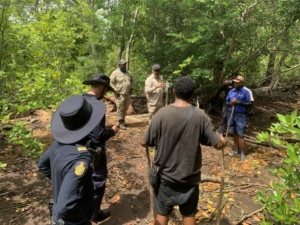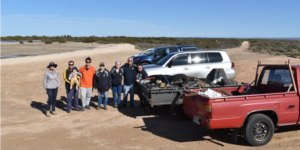National NRM update for July 2022. This update represents just a handful among the hundreds of NRM projects going on across Australia, which are made possible through funding from the Australian Government and from respective State governments.
 Funded by Melbourne Water, a new 'fish ladder' in Darebin Creek has been installed to allows fish to migrate past a concrete barrier by swimming through eddies and pools to water on the other side. The $350,000 project is made up of a series of meticulously designed rock works to modify a concrete barrier in Darebin Parklands.
Funded by Melbourne Water, a new 'fish ladder' in Darebin Creek has been installed to allows fish to migrate past a concrete barrier by swimming through eddies and pools to water on the other side. The $350,000 project is made up of a series of meticulously designed rock works to modify a concrete barrier in Darebin Parklands.
The migratory journey up this waterway is key to the lifecycle of species like Common Galaxias and Short Finned Eel, who move from sea to river. Restoring this ability is crucial for the diversity and spread of native fish species in Victoria’s rivers and creeks. Read more about the project here.
 South Coast NRM are celebrating the second successful south coast translocation of one of WA’s rarest birds following the release of seven threatened Western Ground Parrots by the Department of Biodiversity and Conservation (DBCA) at a remote site east of Albany. They join seven birds previously released at the site in Autumn 2021, with DBCA researchers hoping to establish a second wild population to help safeguard the critically endangered species from threats such as bushfires, and feral cats and foxes.
South Coast NRM are celebrating the second successful south coast translocation of one of WA’s rarest birds following the release of seven threatened Western Ground Parrots by the Department of Biodiversity and Conservation (DBCA) at a remote site east of Albany. They join seven birds previously released at the site in Autumn 2021, with DBCA researchers hoping to establish a second wild population to help safeguard the critically endangered species from threats such as bushfires, and feral cats and foxes.
South Coast NRM are supporting this project through feral animal control and fauna surveying to assist in the successful translocation. This work is jointly funded by DBCA, BirdLife Australia, Friends of the Western Ground Parrot and the Australian Government’s National Landcare Program.
 Following the black summer bushfires, Murray Local Land Services in NSW have been working with the local Wiradjuri community around Tumut to support people to work on Country and helping the land heal from the impacts of fire. Together they are building on local knowledge with a series of training programs for seed collection, cultural site identification, replanting programs, monitoring and cultural burning. This project has been supported by the Australian Government's Bushfire Recovery Program for Wildlife and their habitat. Click here to watch the video.
Following the black summer bushfires, Murray Local Land Services in NSW have been working with the local Wiradjuri community around Tumut to support people to work on Country and helping the land heal from the impacts of fire. Together they are building on local knowledge with a series of training programs for seed collection, cultural site identification, replanting programs, monitoring and cultural burning. This project has been supported by the Australian Government's Bushfire Recovery Program for Wildlife and their habitat. Click here to watch the video.
 In a boost for the region, 30 Torres Strait Regional Authority (TSRA) Rangers are now trained and ready to help patrol, protect and preserve local waters after completing their Certificate IV in Government Investigations (Regulatory Compliance). Rangers are on the frontline when it comes to caring for Country and conservation in the Torres Strait and this training, combined with local rangers’ knowledge and community links can help local people better understand the rules to keep Sea Country safe, healthy and plentiful for future generations.
In a boost for the region, 30 Torres Strait Regional Authority (TSRA) Rangers are now trained and ready to help patrol, protect and preserve local waters after completing their Certificate IV in Government Investigations (Regulatory Compliance). Rangers are on the frontline when it comes to caring for Country and conservation in the Torres Strait and this training, combined with local rangers’ knowledge and community links can help local people better understand the rules to keep Sea Country safe, healthy and plentiful for future generations.
Including this latest ranger group, more than 40 TSRA Rangers have completed the training since 2017. The course was funded as part of the Capacity Building of Indigenous Ranger Strategy provided by the National Indigenous Australians Agency to help build the technical skills and capabilities of Torres Strait Islander and Aboriginal rangers across Australia.
 SA’s Eyre Peninsula Landscape Board has been focusing on cleaning up and revegetating important saltmarsh areas across the Eyre Peninsula as part of the Australian Government funded Saltmarsh Threat Abatement and Recovery (STAR) Project.A clean-up at the Cowleds Landing Sanctuary Zone near Whyalla filled a large trailer and ute with rubbish and debris.
SA’s Eyre Peninsula Landscape Board has been focusing on cleaning up and revegetating important saltmarsh areas across the Eyre Peninsula as part of the Australian Government funded Saltmarsh Threat Abatement and Recovery (STAR) Project.A clean-up at the Cowleds Landing Sanctuary Zone near Whyalla filled a large trailer and ute with rubbish and debris.
Landscape officers have also been undertaking revegetation work at fragile saltmarsh sites including in the western Eyre Peninsula. Previously samphire revegetation on the western EP has involved the ripping method. This time samphire tube stock has been trialled and planted on 25 ha of degraded samphire in Venus Bay containing varying soil types and salinity levels. Revegetation work at Acraman Creek is also trialling areas of tube stock planted over 30 hectares with works assisted by Far West Coast Aboriginal Corporation Rangers. Read more at the link.
 As part of the 2021-22 Western Weed Management Program, 28 landholders in NSW’s Euabalong area were contracted to carry out control works to improve and sustain the condition of close to 25,000 hectares of natural resources through the control of invasive for African boxthorn, mesquite and cactus. Prior to on-ground works, participating landholders and Western LLS work with local Aboriginal stakeholders to undertake assessments for Aboriginal cultural heritage and record all known sites. This helps to protect Aboriginal cultural heritage values and ensure that sites are not disturbed and are protected into the future.
As part of the 2021-22 Western Weed Management Program, 28 landholders in NSW’s Euabalong area were contracted to carry out control works to improve and sustain the condition of close to 25,000 hectares of natural resources through the control of invasive for African boxthorn, mesquite and cactus. Prior to on-ground works, participating landholders and Western LLS work with local Aboriginal stakeholders to undertake assessments for Aboriginal cultural heritage and record all known sites. This helps to protect Aboriginal cultural heritage values and ensure that sites are not disturbed and are protected into the future.
With African Boxthorn out competing the native understory and altering the structure of the vegetation community, as well as being a haven for pest animals such as foxes and rabbits, the control works were carried out in targeted areas to help protect Plains-wanderer habitat and Coolibah Black-Box Threatened Ecological Communities.
 Queensland’s Burnett Mary Regional Group (BMRG) is wrapping up one of its largest projects, the Natural Resource Investment Program (NRIP). The NRIP project has focused on repairing wetlands and riparian zones and improving grazing practices on a total of forty sites to produce positive on-ground outcomes for natural resources. NRIP has also supported the Paddock to Reef program and given BMRG the ability to conduct regional coordination and evaluation on regional practices. Read more about the NRIP here.
Queensland’s Burnett Mary Regional Group (BMRG) is wrapping up one of its largest projects, the Natural Resource Investment Program (NRIP). The NRIP project has focused on repairing wetlands and riparian zones and improving grazing practices on a total of forty sites to produce positive on-ground outcomes for natural resources. NRIP has also supported the Paddock to Reef program and given BMRG the ability to conduct regional coordination and evaluation on regional practices. Read more about the NRIP here.
 A recent aerial operation has removed 243 fallow deer across 6,800 ha of SA’s Deep Creek National Park, and over 430 feral goats from the Montacute region, helping preserve native vegetation and threatened species. Landscapes Hills and Fleurieu works with partners to coordinate feral deer and goat control through the Regional Grazing Pressure Management program.
A recent aerial operation has removed 243 fallow deer across 6,800 ha of SA’s Deep Creek National Park, and over 430 feral goats from the Montacute region, helping preserve native vegetation and threatened species. Landscapes Hills and Fleurieu works with partners to coordinate feral deer and goat control through the Regional Grazing Pressure Management program.
Grazing pressure from introduced herbivores can have substantial impacts on primary production, water catchments, native vegetation and threatened flora and fauna. Continued control efforts and coordination between public and private landholders will be required over the coming years in order to achieve a landscape scale reduction in numbers of both feral deer and feral goats.
https://www.landscape.sa.gov.au/hf/news/feral-deer-numbers-reduced-in-deep-creek-national-park
 Twelve mooring leaseholders in southern Tasmania’s North West Bay have volunteered to swap their chain moorings over to CSIRO-engineered environmentally-friendly moorings (EFMs). These moorings provide a safe and reliable alternative to help protect sensitive habitats – such as those that can be found in the seagrass meadows of North West Bay. Traditional moorings cause scraping along the seabed and damage seagrass, displacing the many species that rely on this habitat to survive.
Twelve mooring leaseholders in southern Tasmania’s North West Bay have volunteered to swap their chain moorings over to CSIRO-engineered environmentally-friendly moorings (EFMs). These moorings provide a safe and reliable alternative to help protect sensitive habitats – such as those that can be found in the seagrass meadows of North West Bay. Traditional moorings cause scraping along the seabed and damage seagrass, displacing the many species that rely on this habitat to survive.
NRM South is leading this pilot study of EFMs as part of a partnership project with CSIRO and OzFish Unlimited. NRM South spoke with a number of these volunteers to find out more about their motivations for joining this project and have provided a summary of their responses at the link.
 In recent months OceanWatch has been conducting a series of bushfire resilience tours in affected catchments on the NSW south coast. Follow the link to view a video of their first tour in the Clyde River. This tour took participants on a journey upriver to see and discuss the impacts of the 2019-2020 bushfires on the aquatic environment, as well as discussing practices one can employ to minimise these impacts. Click here to view the video.
In recent months OceanWatch has been conducting a series of bushfire resilience tours in affected catchments on the NSW south coast. Follow the link to view a video of their first tour in the Clyde River. This tour took participants on a journey upriver to see and discuss the impacts of the 2019-2020 bushfires on the aquatic environment, as well as discussing practices one can employ to minimise these impacts. Click here to view the video.
